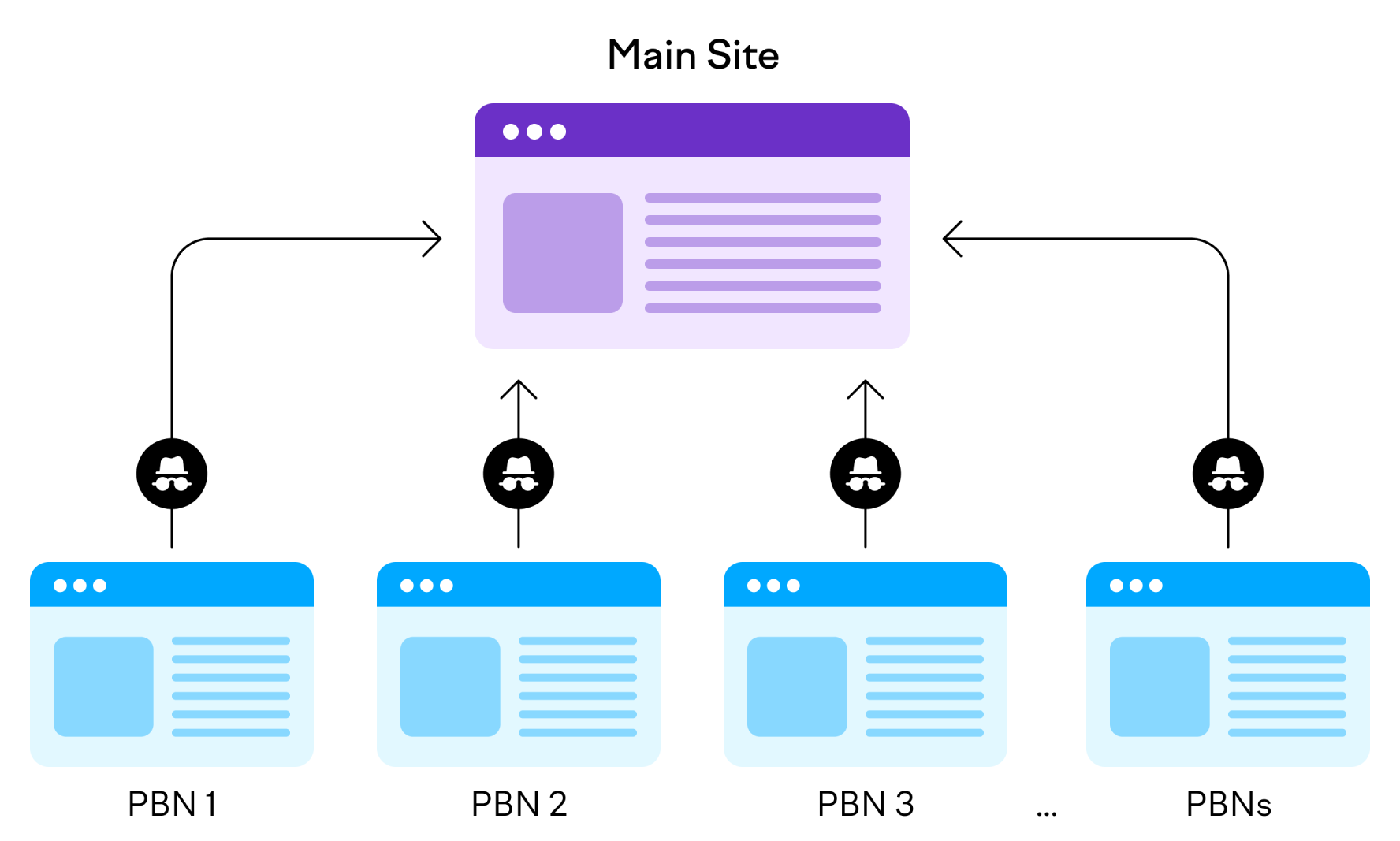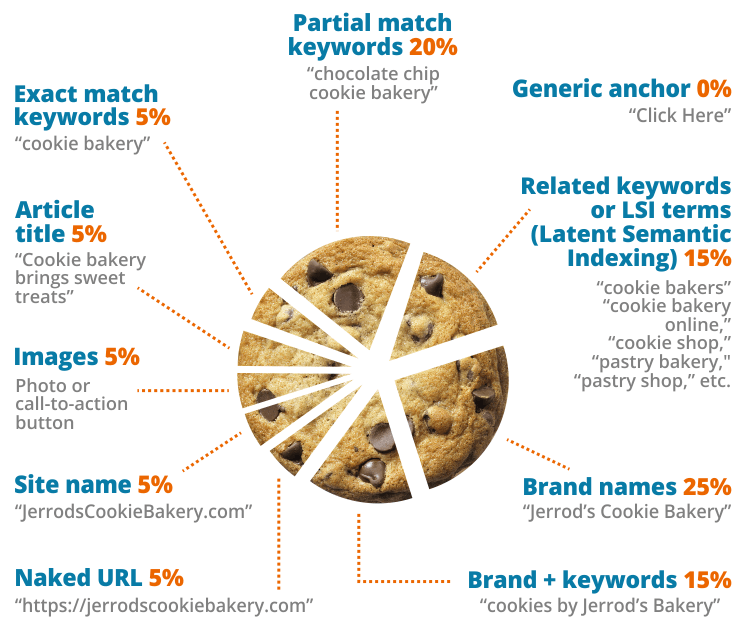As part of Search Engine Optimization (SEO), “PBNs” stand for Private Blog Networks. These are networks of websites used to build backlinks to a single site, with the goal of boosting its authority and rankings in search engines. The concept of PBNs has become controversial due to their association with black hat SEO tactics, which are strategies aimed at manipulating search engine rankings.
What Are PBNs and How Do They Work?
Private Blog Networks, or PBNs, involve creating or acquiring multiple websites that interlink and point to a main website, often using expired domains with high domain authority. These backlinks are intended to enhance the main site’s search engine rankings. While this method might temporarily boost rankings, it’s considered a violation of Google’s guidelines, which frown upon any form of link schemes designed to manipulate rankings.
The Role of Backlinks in PBNs
Backlinks play a crucial role in the success of PBNs. In essence, PBNs exploit the power of backlinks by artificially inflating the link profile of a target site. This strategy is rooted in the idea that more links from authoritative domains can enhance a site’s credibility in the eyes of search engines like Google.
How Backlinks Function in PBNs
- Building Authority: Each site within the PBN is built or purchased with the intention of linking to the main site. These links pass on authority, especially if the PBN sites have strong backlink profiles themselves (e.g., expired domains with existing links from reputable sites). The more high-quality backlinks a site receives, the more likely it is to rank higher on search engine results pages (SERPs).
- Anchor Text Manipulation: PBNs allow webmasters to control the anchor text of backlinks. This is crucial because the anchor text can influence the relevancy of the link, helping the target site rank for specific keywords. For example, if the desired keyword is “best coffee shop,” PBN sites can consistently use that phrase as the anchor text when linking to the main site, boosting its relevance for that term.
- Simulating Organic Growth: PBNs are often designed to mimic organic link growth. Instead of blasting out hundreds of low-quality links, PBN operators carefully curate the appearance of natural linking patterns. This might include varied anchor text, links from different types of content, and links spread out over time to avoid suspicion from search engines.
- Domain Authority Transfer: One of the key strategies in PBNs is leveraging expired domains with existing authority. These domains, which already have backlinks from reputable sources, are repurposed within the PBN. By maintaining the quality and relevance of the content on these sites, PBN operators aim to retain their authority, which is then transferred to the target site through backlinks.

Should You Use PBNs? A Detailed Look at the Pros and Cons
Private Blog Networks (PBNs) have long been a topic of debate in the SEO world. They can be an appealing tactic for quickly boosting rankings, but the risks involved are significant. Before diving into PBNs, it’s essential to weigh the pros and cons.
Pros of Using PBNs
- Quick SEO Boost: PBNs can provide a fast increase in rankings by creating a network of authoritative backlinks.
- Control Over Links: With PBNs, you have full control over your backlink profile, including anchor text and link placement.
- Competitive Edge: In highly competitive niches, PBNs can give you an edge by rapidly improving your website’s authority.
Cons of Using PBNs
- Risk of Penalties: Google actively penalizes websites using PBNs, which can lead to significant ranking drops or even de-indexing from search results.
- Cost and Maintenance: Building and maintaining a PBN is expensive and time-consuming. It requires buying domains, hosting, and creating content that doesn’t appear spammy.
- Ethical Concerns: Using PBNs is considered a black hat SEO tactic, which goes against Google’s guidelines. It can damage your reputation if discovered by clients or competitors.
Should You Use PBNs?
While PBNs offer short-term gains, they come with long-term risks. If you’re looking for sustainable growth and wish to avoid penalties, focusing on white hat SEO strategies like high-quality content and natural link building is a safer bet. However, for those willing to take the risk in highly competitive niches, PBNs might still have a place in your strategy—but proceed with caution.
Risks Associated with PBNs
Using PBNs can be risky. Google has increasingly sophisticated algorithms to detect and penalize sites involved in manipulative link schemes. If caught, a site could face penalties such as a drop in rankings or even removal from search results entirely. Additionally, maintaining a PBN is resource-intensive, requiring constant attention to avoid detection.
1. Google Penalties:
Google’s algorithms are designed to identify and penalize manipulative link schemes, including PBNs. If caught, your site could suffer severe consequences, such as a dramatic drop in rankings, traffic loss, or even complete de-indexing from search results.
- Manual Action Penalties: Google may issue a manual penalty if they directly discover your PBN links. This usually results in a significant drop in rankings or a complete removal from Google’s index. Recovering from such penalties is difficult and may require extensive cleanup of links and reconsideration requests.
- Algorithmic Penalties: Even if your PBN isn’t manually flagged, Google’s algorithm updates, like Penguin, are increasingly effective at detecting unnatural linking patterns. If your site is caught in an algorithmic penalty, your rankings could drop without a clear indication of what caused it, making recovery even harder.
2. Wasted Investment:
Creating and maintaining a PBN is resource-intensive. You need to purchase domains, pay for hosting, and create content that appears legitimate. If Google penalizes your site, all the money, time, and effort you’ve invested could be rendered useless.
- Domain Costs: Purchasing expired domains with good metrics can be expensive, and if those domains are flagged as part of a PBN, their value plummets.
- Hosting and Content Expenses: Maintaining multiple websites with unique IP addresses and decent-quality content to avoid detection requires ongoing financial investment. If the PBN fails, all that effort and money are lost.
3. Ongoing Maintenance and Management:
Operating a PBN isn’t a set-it-and-forget-it strategy. It requires continuous upkeep to avoid detection by search engines. This includes regularly updating content, ensuring sites remain indexed, and masking any signs that the network is a PBN.
- Content Creation: To make the PBN appear legitimate, each site requires fresh and relevant content. Low-quality or thin content can raise red flags with search engines, making regular updates essential.
- Technical Maintenance: Managing multiple domains across various hosting providers and ensuring the network isn’t easily traceable is labor-intensive. You’ll need to constantly check for technical issues, such as deindexation of PBN sites or downtime, which can negatively impact your main site.
4. Reputation Damage:
If competitors, clients, or industry peers discover that you are using PBNs, your reputation could suffer. Trust and credibility are critical in digital marketing, and being associated with black hat SEO tactics can damage your professional image.
- Client Trust: If you’re managing SEO for clients and they discover you’ve been using PBNs, they may lose confidence in your services, especially if their site gets penalized as a result.
- Competitor Exploitation: Competitors who uncover your PBN strategy could report your network to Google, resulting in penalties. They might also use it against you in a negative PR campaign, further damaging your reputation.
5. Lack of Long-Term Sustainability:
PBNs may deliver short-term results, but they are not a sustainable SEO strategy. As Google’s algorithms continue to evolve, PBNs become increasingly risky. A site that relies heavily on PBNs may struggle to maintain rankings over time, especially as search engines get better at identifying and penalizing such practices.
- Algorithm Updates: Google’s regular updates continue to improve their ability to detect and penalize unnatural links. What works today might not work tomorrow, making PBNs a volatile and unreliable tactic.
- Short-Term Gains, Long-Term Losses: The benefits of PBNs might be short-lived, and the long-term damage from penalties or reputation loss can be hard to recover from. Building a sustainable SEO strategy through high-quality content and legitimate link-building methods is a safer approach in the long run.
PBNs and SEO: A Double-Edged Sword
For SEO professionals, PBNs represent both a potential opportunity and a significant risk. While they can deliver short-term gains, the long-term consequences can be severe. This is why many SEO experts advise focusing on white hat SEO strategies, which prioritize organic growth through high-quality content and natural link-building practices.
If You Want To Use PBNs Follow These Rules
Private Blog Networks (PBNs) are a contentious topic in SEO. For those who decide to use them, adhering to best practices can help mitigate risks. Below are the key strategies:
1. Diversify Hosting and IP Addresses
One of the biggest giveaways of a PBN is using the same hosting or IP addresses for all sites. Diversify your hosting providers and IP addresses to avoid detection.
2. Use Unique, High-Quality Content
Thin or duplicate content across your PBN sites can raise red flags. Ensure each site has unique, high-quality content that adds real value to users. This helps your sites look legitimate and less like part of a PBN.
3. Vary Link Patterns and Anchor Text
Avoid using the same anchor text or linking patterns across your PBN. Randomize your linking strategies to make it harder for search engines to detect manipulation. Mix branded, generic, and long-tail keywords to keep your link profile natural.

4. Build Social Proof
Adding social media profiles and ensuring some level of user engagement on your PBN sites can make them appear more credible. Social signals can help reinforce the legitimacy of your PBN sites.
5. Regularly Update and Maintain Your Sites
PBNs require ongoing maintenance to avoid detection. Update content regularly, check for technical issues, and ensure your sites stay indexed by search engines. Neglected sites can easily be flagged as part of a PBN.
6. Avoid Over-Reliance on PBNs
While PBNs can provide a boost, don’t rely on them as your sole SEO strategy. Complement them with white hat techniques like content marketing and legitimate link building. Diversifying your SEO efforts reduces the impact if your PBN is detected.
7. Monitor Competitors and Stay Updated
Keep an eye on your competitors and the SEO landscape. As search engines improve their algorithms, the risks of PBNs evolve. Stay updated on changes to mitigate potential threats and adapt your strategy accordingly.
Alternatives to PBNs
Rather than relying on PBNs, businesses can focus on building their domain authority through legitimate means. This includes creating valuable content that naturally attracts backlinks, engaging in outreach to acquire quality links, and fostering relationships with influencers in their niche. These methods align with Google’s guidelines and help ensure sustainable, long-term success.
1. Content Marketing:
Creating high-quality, valuable content is one of the most effective ways to attract organic backlinks. Focus on producing content that resonates with your target audience, solves problems, or offers unique insights.
2. Guest Blogging:
Contributing guest posts to reputable sites in your niche can build natural backlinks and establish authority. Unlike PBNs, this approach fosters relationships and credibility.

3. Outreach and Relationship Building:
Connect with influencers, bloggers, and industry leaders for collaboration opportunities. Building genuine relationships can lead to natural link-building opportunities through partnerships, interviews, or collaborative content.
4. Social Media and Content Distribution:
Promote your content across social media channels to increase its visibility and likelihood of attracting organic backlinks. Engaging in content syndication or leveraging platforms like Medium can also extend your reach.
5. Broken Link Building:
Identify broken links on high-authority websites in your niche and offer your content as a replacement. This approach provides value to webmasters while earning you a quality backlink.
6. Infographics and Visual Content:
Creating shareable infographics, videos, and other visual content can attract backlinks as other sites embed your media with proper credit. Visual content is highly engaging and can naturally drive traffic and links.
7. Local SEO and Citations:
For businesses with a local focus, optimizing for local SEO and acquiring citations in local directories can build authority. This includes getting listed in relevant local and niche directories, which can enhance your website’s visibility.

8. Earned Media and PR:
Building relationships with journalists and media outlets can result in earned mentions and backlinks. Craft compelling stories or press releases that align with your brand’s mission and industry trends.
9. Community Engagement:
Participate in forums, Q&A sites, and online communities related to your niche. Contributing helpful information can lead to organic backlinks when users reference your expertise.
10. Internal Linking:
Optimizing your internal link structure can improve SEO without the need for external links. By ensuring a strong, well-organized internal linking strategy, you can boost page authority within your site.
FAQs on PBNs (Private Blog Networks)
1. What is a PBN? A Private Blog Network (PBN) is a network of websites used to build backlinks to a target site, boosting its SEO rankings.
2. Are PBNs legal? While PBNs are not illegal, they violate Google’s guidelines and are considered a black hat SEO tactic.
3. Can PBNs boost rankings? Yes, PBNs can boost rankings temporarily, but they carry significant risks of penalties from search engines.
4. What are the risks of using PBNs? Google can penalize your site, leading to ranking drops or even removal from search results.
5. How do I maintain a PBN? Maintaining a PBN requires diversifying hosting, creating unique content, and regularly updating sites to avoid detection.
6. Is there an alternative to PBNs? Yes, white hat SEO strategies like content marketing, outreach, and building genuine relationships with other sites offer sustainable alternatives without the risks associated with PBNs.
7. What happens if my PBN gets penalized? If your PBN is penalized, your primary site could see significant drops in rankings, and recovery can be difficult, often requiring a cleanup of links and a reconsideration request to Google.
8. How can I avoid detection when using a PBN? To avoid detection, use different IP addresses, avoid footprints, and make each PBN site appear as a legitimate standalone website. However, it’s important to note that no strategy guarantees complete safety from penalties.
9. Are PBNs still effective in 2024? While PBNs can still be effective, search engines like Google continue to improve their algorithms, making it riskier than ever. Sustainable, white hat SEO practices are often recommended for long-term success.
Understanding “PBNs meaning” and their implications is crucial for anyone involved in SEO. While Private Blog Networks might seem like a shortcut to higher rankings, they carry significant risks that can outweigh the rewards. By focusing on ethical, sustainable SEO practices, businesses can build a strong online presence without the dangers associated with PBNs.